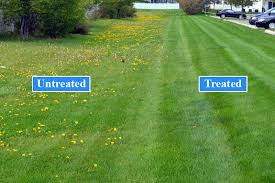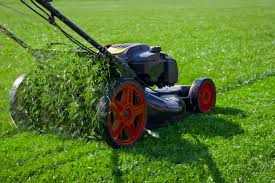Grass Treatment is all about taking care of your grass so it grows nice and green. Taking care of your grass is important because it makes your yard look nice and you can play on it too.
First, you need to water your grass. Just like people need water to stay healthy, grass needs water too. Use a sprinkler or a hose to give your grass a drink. Don’t give it too much water, though, because that can be bad for the grass.
Next, you need to cut the grass. Use a lawnmower to make the grass shorter. But don’t cut it too short or it might get hurt. Leave the grass a bit tall so it can still get sunlight and grow strong.
Fertilizer is like food for your grass. You can spread it on the grass to help it grow better. Fertilizer has special things in it that the grass likes. But be careful not to put too much or it could be bad for the grass.
Sometimes, your grass might get sick from bugs or diseases. If you see brown spots or weird bugs on your grass, you can use treatments to make it better. There are special sprays you can use to get rid of bugs and make the grass healthy again.
Sunlight is important for grass too. Make sure it gets enough sun during the day. If there are big trees around blocking the sun, you might need to trim the branches so the grass can see the sun.
Lastly, be careful when you walk or play on the grass. If you run around a lot, the grass can get squished and it might not grow well. Try to walk and play gently on the grass.
Remember, taking care of your grass is like taking care of a pet. Give it water, food (fertilizer), sunlight, and keep it safe from bugs and things that might hurt it. If you do all these things, your grass will be happy and your yard will look really nice.
Read Also: Causes of Diseases in Farm Animals and How to Prevent Disease OutBreak
Best ways to Treat Grass

The best ways to treat grass involve a combination of proper watering, mowing, fertilizing, and addressing potential issues. Here’s a simple guide to help you treat your grass effectively:
1. Watering: Give your grass a good drink of water, especially during dry periods. Water deeply and less frequently to encourage deep root growth. Early morning or late afternoon is the best time to water, as it reduces water loss due to evaporation.
2. Mowing: Regular mowing helps keep your grass healthy. Don’t cut more than one-third of the grass height at a time. Cutting the grass too short can stress it and make it vulnerable to pests and diseases.
3. Fertilizing: Feed your grass with a balanced fertilizer to provide it with essential nutrients. Choose a fertilizer with the right ratio of nitrogen, phosphorus, and potassium. Follow the recommended application rates to avoid over-fertilizing.
4. Aeration: If your soil is compacted, it’s a good idea to aerate your lawn. Aeration involves poking small holes in the soil to allow air, water, and nutrients to reach the grass roots more effectively.
5. Weed Control: Keep an eye out for weeds and remove them promptly. You can use manual methods like pulling them out or using natural weed killers. Preventing weeds from establishing helps your grass grow better.
6. Pest and Disease Management: If you notice pests or signs of disease on your grass, take action to address the issue. Use appropriate treatments like insecticides or fungicides, but be sure to follow the instructions carefully.
7. Sunlight: Ensure that your grass gets enough sunlight. Trim overhanging branches from trees that might be blocking sunlight and inhibiting grass growth.
8. Seasonal Care: Adjust your treatment approach based on the seasons. For instance, in the fall, consider overseeding to fill in thin areas and prepare your lawn for the next growing season.
9. Soil Testing: Periodically test your soil’s pH and nutrient levels. This helps you determine if your grass is getting the right nutrients and allows you to make adjustments as needed.
10. Proper Cleanup: Keep your lawn free of debris and fallen leaves. These can block sunlight and create a damp environment that promotes disease growth.
Remember, each type of grass has specific needs, so it’s important to know what kind of grass you have and tailor your treatment plan accordingly. Consistency and patience are key to achieving a healthy and vibrant lawn.
Importance of Grass Treatment

Here are five important reasons to emphasize the treatment and care of grass:
1. Enhanced Curb Appeal: Well-maintained grass enhances the overall appearance of your property. A lush, green lawn can make your home more inviting and aesthetically pleasing to both residents and visitors.
2. Environmental Benefits: Healthy grass acts as a natural air purifier by absorbing carbon dioxide and releasing oxygen. It also helps in reducing soil erosion and filtering rainwater, contributing to a healthier local environment.
3. Recreational Space: A cared-for lawn provides a safe and comfortable area for outdoor activities. Whether it’s playing with children, hosting gatherings, or enjoying leisure time, a well-maintained lawn offers a versatile space for various recreational purposes.
4. Temperature Regulation: Grass plays a role in temperature regulation by cooling the surrounding area. On hot days, a grassy area can be significantly cooler than paved surfaces, contributing to a more comfortable outdoor environment.
5. Economic Value: Properly treating and maintaining grass can increase the value of your property. A manicured lawn adds to the overall value of your home and can even attract potential buyers if you decide to sell in the future.
These reasons collectively highlight the significance of grass treatment, not only for aesthetic purposes but also for environmental, functional, and economic benefits.
Read Also: 18 Medicinal Health Benefits of Microloma (Microloma sagittatum)
Best way to Grow Grass

Growing grass might seem a little tricky, but it’s actually quite simple when you know the best way to do it. Whether you’re starting a new lawn from scratch or trying to make your existing grass healthier, following these steps can help you achieve a beautiful and green carpet of grass.
1. Choose the Right Type of Grass: First, you need to choose the right type of grass for your area. Some grasses like sunny spots, while others prefer shade. Ask at a garden store or search online to find out which grass suits your place the best.
2. Prepare the Soil: Good soil is like a comfy bed for your grass. Use a shovel to dig up the soil a little bit and remove any rocks or weeds. Then, add some compost or soil conditioner to make the soil nice and soft.
3. Plant the Seeds or Sod: You have two options to start your grass: seeds or sod. Seeds are like tiny magic beans that grow into grass. Sprinkle them evenly on the soil and then gently press them down with a rake. If you choose sod, it’s like a grass carpet that you roll out on the soil.
4. Watering: Just like you need water to grow, so does your grass. Water the soil gently and regularly, especially in the beginning. Keep the soil moist, but not too soggy.
5. Be Patient: Growing grass takes a little time. It won’t happen overnight, so be patient and give it some time to sprout and grow.
6. Mowing: When your grass gets taller, it’s time for a haircut! Use a lawnmower and trim the grass a bit. Don’t cut it too short though, as longer grass is healthier.
7. Fertilize Wisely: Grass likes to eat too! Use a special grass food, also known as fertilizer, to give your grass the nutrients it needs. Follow the instructions on the fertilizer package.
8. Keep Weeds Away: Weeds are like uninvited guests in your grass party. Use a tool to pull them out or use a special spray that kills only the weeds, not your grass.
9. Protect and Enjoy: If you have kids or pets, be careful when they play on the new grass. It needs time to settle and grow strong. Try not to step on it too much.
10. Regular Care: Keep watering, mowing, and fertilizing regularly to help your grass stay healthy and green. If you see any brown spots or problems, look for solutions to fix them.
Remember, growing grass is like having a little green friend. It needs your care and attention, but in return, it will give you a beautiful and cozy space to enjoy with family and friends.
Read Also: Styrofoam Recycling Comprehensive Guide
